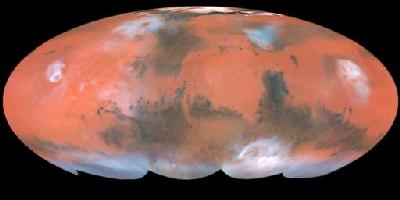During the 1980s and early 1990s, the IMP worked with professional astronomers, providing observers for Lowell Observatory’s International Planetary Patrol and providing quality photographs of Mars to the United States Geological Survey for creating maps of albedo features on the Red Planet. However, federal budget cuts have limited these programs to a narrow scope, and amateur participation has all but disappeared.
Today, the IMP coordinates and instructs its observers in using a variety of methods — including visual, photographic (film and electronic), photometric, and micrometric techniques — for their observations of Mars.
During each apparition, the ALPO Mars Section receives thousands of individual observations consisting of visual disk drawings made with the aid of color filters, black-and-white and color photographs, intensity estimates of light and dark albedo features, color contrast estimates, and micrometer measurements of polar caps, cloud boundaries, and variable surface features. The chronological filing of this large quantity of data requires the observational information obtained for each night to be recorded on one or two standard observing report forms.
It is with this in mind that the ALPO Mars Coordinators have prepared a simple, efficient, and standard Mars observing report form. This form can be used for reporting all types of observations such as micrometry, transit timings, intensity estimates, and so on. Photographs may also be attached to the top or back of the form while the relevant information can be filled in at the telescope. Observational data consist of color filter photography, visual disk drawings, visual photometry (intensity estimates on the standard ALPO scale: 10 = polar brightness, 8 = desert mean brightness, 0 = night sky), micrometry, and CCD imaging. Great emphasis is placed on quality photographs in red, blue, and violet light, full disk drawings using standard color filters, polar cap measurements made with an astronomical micrometer, and on modern observing techniques such as full disk photometry and CCD imaging.
The MarsWatch program was initiated in electronic form in 1996 through the collaboration of astronomers at Cornell University, the Jet Propulsion Laboratory (JPL) Mars Pathfinder Project, and the Mars Section of ALPO as a vehicle through which Mars astronomers worldwide can upload their observations to an online archive site at JPL. At the site, you will find images of Mars contributed by amateurs and professionals, tools to aid you in planning your own Mars observations, current and past issues of the International MarsWatch Electronic Newsletter, and links to other relevant sites on the Internet. The present apparition is particularly important because two NASA missions (Mars Global Surveyor and Mars Odyssey) will be continuing routine imaging during this time. The project will maintain a webpage and archive site in association with the MarsWatch and at the ALPO Mars section website.










